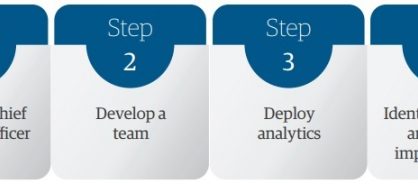- Point of view
Four steps towards exceptional customer experiences

In today’s volatile business environment, delivering superior customer experiences is a critical competitive capability. A well-thought-out business-to-business customer experience strategy is a differentiator, increases customer loyalty, and grows your market share. Technological change, macro and socioeconomic pressures, blurring competitor lines, and emerging digital-first rivals are just some of the threats to companies’ revenues, profitability, and share of wallet.
In a disrupted environment, creating and managing a superior B2B customer experience (CX) could be the determining factor for your business’ success. In fact, consulting firm McKinsey has found that that for every 10 percentage point increase in customer satisfaction, a company can increase revenues by up to 3%. After all, satisfied customers will:
- Remain loyal and continue to do business with you
- Show interest in trying out new products and services
- Become brand advocates who recommend your products and services to others
- Be inclined to buy add-on services, which creates crossselling and upselling opportunities
If delivering exceptional customer experience leads to such great opportunities, why do most enterprises have sub-par CX? Some of the challenges include:
- Individual functions, such as sales, customer service, and supply chain management collect customer feedback, but they work in silos, which prevents them from getting a full view of the customer journey across all touch points or channels
- In many organizations, there isn’t a single person responsible for managing CX. In fact, some have yet to think about or prioritize CX initiatives
- Customer data is unstructured and sits in silos. Businesses spend too much time collating it so there’s no time to uncover the insights that support meaningful decisions
Creating a superior customer experience
To transform the experience for your customers, we’ve compiled the four steps (figure 1) that leading companies take to improve their competitive position as well as their bottom and top lines:
Figure 1: Steps to transform customer experience

1. Appoint a chief customer officer
It all starts at the top. Your leadership has to recognize the importance of improved CX strategies. And they need to define how the company’s vision statement translates into its aspiration of delivering excellent CX.
Who is best positioned to lead this initiative? You need a seasoned C-level executive who can cut across functional siloes, evangelize the importance of measuring CX, and oversee organizational changes to determine priorities and allocate resources.
This customer champion, often called the chief customer officer, might be your head of sales, customer service, or supply chain operations. Indeed most customer touchpoints for B2B repeat business sit in order management or order to cash. Whoever you select will be responsible for shaping your organization’s CX program, and ensuring the new CX vision is institutionalized throughout the business and its network of external partners, including suppliers and logistics providers.
Take a copy for yourself
2. Form a CX team
Reporting to the chief customer officer, team members must have a strong understanding of your overall business, from sales to marketing to operations and customer service. This team will collaborate with business functions, such as supply chain, sales, and customer service, to decide how to segment your customers.
The team will then design the CX program and define metrics to measure success. While these metrics will vary between companies, they often include:
- How easy it is to find your product or service
- How long it takes to convert a quote into an order
- Quote accuracy
- Delivery timeliness
- Renewal rates
A critical factor in determining the effectiveness of the CX team is change management. The team needs to be adept at communicating the goals and objectives of the CX program to functional leaders, so that everyone is clear on roles, responsibilities, and what has to be done to be successful.
3. Enable the team with analytics
The data the CX team needs sits in multiple places throughout your company, including ERP, CRM, and business intelligence systems. A lot of that data would come from order management, such as delivery accuracy, communication frequency, or customer service quality. To bring that data together in one place so it can be easily accessed and used, you need a robust analytics engine — one that leverages robotic process automation and dynamic workflows to integrate data and deliver actionable insights.
The CX team will use this engine to analyze the data for each metric and for each customer segment, and calculate CX scores across all customer touch points. They’ll then match the calculated CX scores to qualitative feedback they’ve received from each of the company’s business functions. This gives you a clear picture of what is and isn’t working for each customer segment, and helps uncover lost opportunities.
4. Govern the identified improvements
Armed with the data, the CX team can then see where problems lie — for example, issues in supply chain operations due to consistently late deliveries — and have frank and open discussions about the root cause. Due to the objectivity of the collected data, the CX team and the functional head can then agree on a specific action plan to fix the issue.
To make sure that the fix is working, the CX team should create a continuous loop of check points to analyze the metric over a period of time. This type of governance is necessary to drive — and re-jig if needed —improvements that can transform the customer experience.
A superior customer experience delivers tangible outcomes
An integrated and holistic CX strategy can lead to impressive revenue and retention boosts, and equally substantial decreases in operating costs and revenue leakage. Our experience shows that:
- Customer retention rates can increase to over 95%. And the longer customers stay with you, the more they contribute to recurring revenue
- Fixing the issues your customers are facing can reduce revenue leakage by almost one percentage point
- By creating a strong governance structure and tracking customer experience metrics regularly, you can identify opportunities to optimize your operating costs — for example, using automation to process orders faster improves productivity
Creating customer experiences that grow revenues, reduce revenue leakage, and increase customer retention and advocacy isn’t easy. But by having the right people, governance structure, and analytics engine in place, you’ll be well ahead of the game and your competition.
Case study
Enhance customer experience and boost revenues
Situation
One of North America’s largest consumer packaged goods companies faced falling levels of customer satisfaction and blows to topline revenue. To grow in a highly competitive market, the company needed to streamline its operations, improve CX, and create stronger customer loyalty.
Solution
We partnered with the company and deployed our analytics and data assessment engine — a customer experience, sales experience, complexity, and risk framework. The company used it to assess customer satisfaction for its top-20 customers. The framework provided insights and enabled the company to identify areas it needed to improve, including order fulfillment and on-time delivery, and developed an action plan to fix the problems.
Impact
In just one year, the CPG firm increased the revenue it receives from one of its top retailers by 5% and from other key retailers by over 1%.